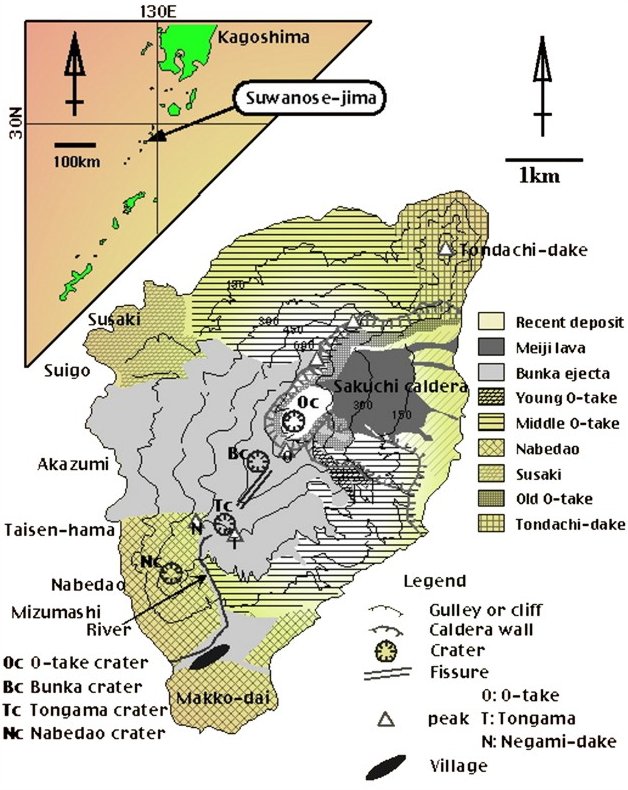Suwanosejima, which lies within the Ryukyu Islands, is one of Japan’s most active volcanoes, erupting almost continuously between the 1950s and mid 1990s. It has two active craters, the central Otake crater and the Bunka crater, to the southwest. While the frequency of these eruptions has declined, the volcano remains active, with strombolian and vulcanian type eruptions occurring every 2 to 4 weeks.

The geology of Suwanosejima, an 8 km long volcanic island. Source: Taketo Shimano/The Smithsonian National Museum of Natural History.
Strombolian eruptions, typified by the activity of the Italian volcano Stromboli, consist of distinct bursts of lava from a magma-filled conduit. The explosions are caused by the bursting of large bubbles of gas that are released from a basaltic to basaltic andesite lava. Vulcanian eruptions, on the other hand, occur when the magma is more viscous (andesitic, dacitic, or rhyolitic). Vulcanian eruptions (characteristic of those from the volcanic island of Vulcano) produce large ash clouds and pyroclastic flows (dense currents of hot ash, gas and rock that flow down the flanks of a volcano). The andesitic composition of Suwanosejima’s magma places its activity between the two, with frequent explosions of lava and ash.
The largest historical eruption at Suwanosejima took place over 1813 to 1814, when lava flows from the southwest crater reached the western coast of the island. This eruption culminated in the collapse of the Otake crater, generating a large debris avalanche and a horseshoe-shaped caldera (the Sakuchi caldera) at the volcano’s summit. The photo below, though, shows a more recent eruption that occurred in the Otake crater during November 2010. Explosive eruptions were followed by continuous lava effusion and degassing and large earthquakes associated with the eruption were followed by harmonic tremor lasting minutes to hours.

“Eruption of Suwanosejima volcano, Japan” by Haruhisa Nakamichi, distributed by the EGU under a Creative Commons licence.
Reference:
Iguchi M, Yakiwara H, Tameguri T, Hirabayashi J (2008). Mechanism of explosive eruption revealed by geophysical observations at the Sakurajima, Suwanosejima and Semeru volcanoes. Journal of Volcanology and Geothermal Research. Vol. 178, pp. 1-9.
Imaggeo is the EGU’s online open access geosciences image repository. All geoscientists (and others) can submit their images to this repository and since it is open access, these photos can be used by scientists for their presentations or publications as well as by the press and public for educational purposes and otherwise. If you submit your images to Imaggeo, you retain full rights of use, since they are licensed and distributed by the EGU under a Creative Commons licence.

Gold can be a great investment
I can’t imagine a large earthquake that will last for hours. How long the eruption last? a day so as the earthquake?
Sara Mynott
Harmonic tremors (also known as volcanic tremors) are different to the sudden, rapid release of seismic energy during an earthquake associated with a fault zone. Instead, harmonic tremor is a much longer period (and lower energy) event, typically associated with the underground movement of magma. Often volcanic tremor is only detected by monitoring instruments and cannot be felt by people in the vicinity of the volcano.
I’m unsure how long this particular eruption lasted, but you can get a feel for typical eruption & tremor duration times here (newsworthy details of relatively recent Suwanosejima eruptions).